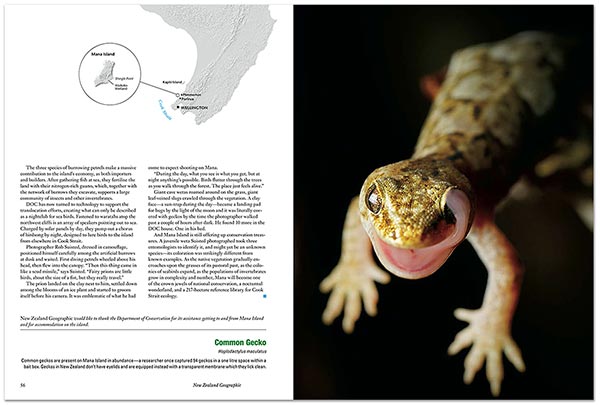Teamed up with Editor of NZ Geographic Magazine, James Frankham, to do a feature on nocturnal Mana Island. Photography of wildlife can be tough, but doing it alone, in the dark, fitting between southerly cold fronts and short timeframes makes it all the sweeter for me when it comes off. I enjoyed this one, and working with James in a can-do style.
The story is contained in the 100th issue of NZ Geographic Magazine (a great milestone for James and the team). How about getting a copy as it’s a beaut read – in fact it’s so good I can’t think of a reason not to. Better still I think you should subscribe). Here are a few of the frames selected for publication and a bit of info behind them.  I wanted to show rarely seen wildlife living on this special island, but contextually it’s so close to our capital city (hence I wanted the light pollution illuminating the skies beyond). The shot above was taken after sitting motionless in the dark for 2 hours in camouflage clothing waiting for the diving petrels to return to their burrows after dark. I was ready to leave when a lone bird landed nearby amongst the flowering native ice plant - what a stroke of luck. It sat there preening while I careffully took it’s portrait.
I wanted to show rarely seen wildlife living on this special island, but contextually it’s so close to our capital city (hence I wanted the light pollution illuminating the skies beyond). The shot above was taken after sitting motionless in the dark for 2 hours in camouflage clothing waiting for the diving petrels to return to their burrows after dark. I was ready to leave when a lone bird landed nearby amongst the flowering native ice plant - what a stroke of luck. It sat there preening while I careffully took it’s portrait.
 Above is one of the island’s geckos. At night they all come out hunting insects and ….are literally everywhere. The house I stayed in for the photo shoot had about 10 living inside, and one night I got home to find one under my pillow! A great opportunity to stay out there. Being ready is key, and here a gecko takes a moment to clear it’s vision while my finger sat on the shutter button.
Above is one of the island’s geckos. At night they all come out hunting insects and ….are literally everywhere. The house I stayed in for the photo shoot had about 10 living inside, and one night I got home to find one under my pillow! A great opportunity to stay out there. Being ready is key, and here a gecko takes a moment to clear it’s vision while my finger sat on the shutter button.
 Little blue penguins (or Fairy Penguins to many) bred on the island and make a heck of a racket with their calls throughout the night – a call that most of us would never have heard. Here I was luckily enough to meet a lone bird coming ashore around midnight with the lights of Plimmerton beyond.
Little blue penguins (or Fairy Penguins to many) bred on the island and make a heck of a racket with their calls throughout the night – a call that most of us would never have heard. Here I was luckily enough to meet a lone bird coming ashore around midnight with the lights of Plimmerton beyond.

The micro snail above I have since discovered represents a huge variety of these creatures, New Zealand apparently harbouring more than our fair share. This one at about 8mm across is considered a giant. Below the snail is a McGregor’s Skink, one of the rarest skinks in the world. The rain drops on it’s head make for me one of my favourite shots from the shoot.
Tech Details: Canon 1Ds MkIII body, with various canon lenses 65mm MP-E macro, 14mm f2.8, 16-35mm f2.8 & 100mm f2.8 macro, plus Canon twin head flash, or single head with softbox.
Cheers, Rob
Related articles: | NZ falcon cover shoot for NZ Geographic Magazine | Mentoring a young gun for NZ Geographic Magazine | New Weta Species for NZ? |













